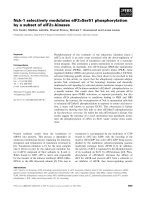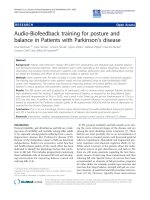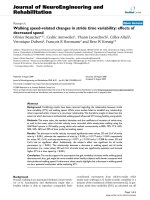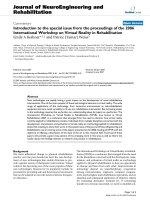Báo cáo hóa học: " Letter to the Editor Remarks on “On a Converse of Jensen’s Discrete Inequality” of S. Simic ´" doc
Bạn đang xem bản rút gọn của tài liệu. Xem và tải ngay bản đầy đủ của tài liệu tại đây (456.88 KB, 4 trang )
Hindawi Publishing Corporation
Journal of Inequalities and Applications
Volume 2011, Article ID 309565, 4 pages
doi:10.1155/2011/309565
Letter to the Editor
Remarks on “On a Converse of Jensen’s Discrete
Inequality” of S. Simi´c
S. Iveli´c
1
and J. P eˇcari´c
2
1
Faculty of Civil Engineering and Architecture, University of Split, Matice Hrvatske 15,
21000 Split, C roatia
2
Faculty of Textile Technology, University of Zagreb, Prilaz Baruna Filipovi
´
ca 30, 10000 Zagreb, Croatia
Correspondence should be addressed to S. Iveli
´
c,
Received 13 January 2011; Accepted 10 February 2011
Copyright q 2011 S. Iveli
´
candJ.Pe
ˇ
cari
´
c. This is an open access article distributed under the
Creative Commons Attribution License, which permits unrestricted use, distribution, and
reproduction in any medium, provided the original work is properly cited.
We show that the main results by S. Simi
´
c are special cases of results published many years earlier
by J. E. Pe
ˇ
cari
´
cetal.1992.
Let I be an interval in and φ : I → aconvexfunctiononI.Ifx x
1
, ,x
n
is any n-
tuple in I
n
,andp p
1
, ,p
n
a positive n-tuple such that
n
i1
p
i
1, then the well known
Jensen’s inequality
φ
n
i1
p
i
x
i
≤
n
i1
p
i
φ
x
i
1
holds see, e.g., 1,page43.Ifφ is strictly convex, then 1 is strict unless x
i
c for all
i ∈{j : p
j
> 0}.
The following results are given in 2.
Theorem 1. Let I a, b,wherea<b, x x
1
, ,x
n
∈ I
n
and p p
1
, ,p
n
,
n
i1
p
i
1,
be a sequence of positive weights associated with x.Letφ be a (strictly) positive, twice continuously
differentiable function on I and 0 ≤ p, q ≤ 1, p q 1. One has that
i if φ is a (strictly) convex function on I,then
1 ≤
n
i1
p
i
φ
x
i
φ
n
i1
p
i
x
i
≤ max
p
pφ
a
qφ
b
φ
pa qb
: S
φ
a, b
, 2
2 Journal of Inequalities and Applications
ii if φ is a (strictly) concave function on I,then
1 ≤
φ
n
i1
p
i
x
i
n
i1
p
i
φ
x
i
≤ max
p
φ
pa qb
pφ
a
qφ
b
: S
φ
a, b
. 3
Both estimates are independent of p.
Theorem 2. Thereisuniquep
0
∈ 0, 1 such that
S
φ
a, b
p
0
φ
a
1 − p
0
φ
b
φ
p
0
a
1 − p
0
b
. 4
The main aim of our paper is to show that the main results presented in 2 are
simple consequences of more general results published in 3. For this purpose, we will first
introduce the concept of positive linear functionals defined on a linear class of real-valued
functions.
Let E be a nonempty set, a nd let L be a linear class of functions f : E →
having the
following properties:
L1 if f, g ∈ L,thenaf bg ∈ L for all a, b ∈
,
L2 1 ∈ L,thatis,ft1forallt ∈ E,thenf ∈ L.
We consider positive linear functionals A : L →
; that is, we assume the following
A1 Aaf bgaAfbAg for all f, g ∈ L, a, b ∈
linearity,
A2 if f ∈ L, ft ≥ 0forallt ∈ E,thenAf ≥ 0 positivity.
If in addition A11issatisfied,thenwesaythatA is a positive normalized linear
functional.
Pe
ˇ
cari
´
c and Beesack 3 proved the next result which presents generalization of
Knopp’s inequality for convex functions see also 4, 1, pages 101–103.
Theorem 3 see 3,Theorem1. Let L satisfy properties (L1), (L2), and let A be a positive
normalized linear functional on L.Letφ be a convex function on an interval I m, M ⊂
−∞ <
m<M<∞,andletJ be an interval in
such that φI ⊂ J.IfF : J × J → is an increasing
function in the first variable, then, for all g ∈ L such that gE ⊂ I and φg ∈ L,onehas
F
A
φ
g
,φ
A
g
≤ max
x∈m,M
F
M − x
M − m
φ
m
x − m
M − m
φ
M
,φ
x
max
θ∈0,1
F
θφ
m
1 − θ
φ
M
,φ
θm
1 − θ
M
.
5
Furthermore, the right-hand side in 5 is an increasing function of M and a decreasing function
of m.
Remark 4. Analogous discrete version of Theorem 3 can be found in 5,Theorem8,
pages 9-10.
Journal of Inequalities and Applications 3
Remark 5. The results of this type are considered in 6, where generalizations for positive
linear operators are obtained. Further generalizations for positive operators are given in 7.
Recently, Iveli
´
candPe
ˇ
cari
´
c 8 obtained generalizations of Theorem 3 for convex functions
defined on convex hulls.
Remark 6. The general results for concave functions can be proved in an analogous way, that
is, for example, in case of positive linear operators given in 6,page37. Therefore, w e will
look back only on case i of Theorem 1.
By applying Theorem 3 to the function Fx, yx/y, we obtain the following result.
Theorem 7. Suppo se that all the conditions of Theorem 3 are satisfied. Then one has
A
φ
g
φ
A
g
≤ max
x∈m,M
M − x
/
M − m
φ
m
x − m
/
M − m
φ
M
φ
x
max
θ∈0,1
θφ
m
1 − θ
φ
M
φ
θm
1 − θ
M
.
6
Furthermore, the right-hand side in 6 is an increasing function of M and a decreasing function
of m.
Theorem 8. Let L, A,andI be as in Theorem 3.Letφ be a positive convex function on I such that
φ
x ≥ 0 with equation for at most isolated points of I (so that φ is strictly convex on I), g ∈ L such
that gE ⊂ I and φg ∈ L.Then,
i
A
φ
g
φ
A
g
M −
x
/
M − m
φ
m
x − m
/
M − m
φ
M
φ
x
, 7
where
x ∈ m, M is uniquely determinated,
ii
A
φ
g
φ
A
g
θφ
m
1 − θ
φ
M
φ
θm
1 − θ
M
, 8
where
θ ∈ 0, 1 is uniquely determinated.
Proof. i Proof is given in 3, Corollary 1, Remark 2see also 1,Remark3.43
pages 102-103.
ii This case follows immediately from i by changing of variable
θ
M − x
M − m
, 9
4 Journal of Inequalities and Applications
so that
x θm
1 − θ
M 10
with 0 ≤ θ ≤ 1.
Remark 9. In the case of a discrete positive functional Af
n
i1
p
i
fx
i
,
n
i1
p
i
1, p
i
> 0,
we can get a discrete version of Theorem 8. It is obvious that the main results presented in 2
are special cases of results given in 3, Theorem 1, Corollary 1, Remark 2.
Note that there is a difference in formulation between Theorems 2 and 8;thatis,
in Theorem 2,thedifferentiability of a function φ is not emphasized which is used in the
proof. Also, the proof of Theorem 2 is completely analogous to the proof of 3, Cor ollary 1,
Remark 2 with the above substitution θ M − x/M − m.
References
1 J. E. Pe
ˇ
cari
´
c, F. Proschan, and Y. L. Tong, Convex Functions, Partial Orderings, and Statistical Applications,
vol. 187 of Mathematics in Science and E ngineering, Academic Press, Boston, Mass, USA, 1992.
2 S. Simi
´
c, “On a converse of Jensen’s discrete inequality,” Journal of Inequalities and Applications,vol.
2009, Article ID 153080, 6 pages, 2009.
3 J. E. Pe
ˇ
cari
´
c and P. R. Beesack, “On Knopp’s inequality for convex functions,” Canadian Mathematical
Bulletin, vol. 30, no. 3, pp. 267–272, 1987.
4 K. Knopp, “
¨
Uber die maximalen Abst
¨
ande und Verh
¨
altnisse verschiedener Mittelwerte,” Mathematische
Zeitschrift, vol. 39, no. 1, pp. 768–776, 1935.
5 D. S. Mitrinovi
´
c, J. E. Pe
ˇ
cari
´
c, and A. M. Fink, Classical and New Inequalities in Analysis,vol.61of
Mathematics and Its Applications, Kluwer Academic Publishers, Dordrecht, The Netherlands, 1993.
6 T.Furuta,J.Mi
´
ci
´
cHot,J.Pe
ˇ
cari
´
c, and Y. Seo, Mond-Pe
ˇ
cari
´
c Method i n Operator Inequalities: Inequalities
for Bounded Selfadjoint Operators on a Hilbert Space, Element, Zagreb, Croatia, 2005.
7 J. Mi
´
ci
´
c, J. Pe
ˇ
cari
´
c, and Y. Seo, “Converses of Jensen’s operator inequality,” Operators and Matrices,vol.
4, no. 3, pp. 385–403, 2010.
8 S. Iveli
´
candJ.Pe
ˇ
cari
´
c, “Generalizations of converse Jensen’s inequality and related results,” Journal of
Mathematical Inequalities, vol. 5, no. 1, pp. 43–60, 2011.









